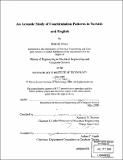An acoustic study of coarticulation patterns in Turkish and English
Author(s)
Ozsoy, Hale H. (Hale Hatice), 1977-
DownloadFull printable version (6.486Mb)
Other Contributors
Massachusetts Institute of Technology. Dept. of Electrical Engineering and Computer Science.
Advisor
Kenneth N. Stevens.
Terms of use
Metadata
Show full item recordAbstract
Studies in Turkish and English had shown that there is a remarkable difference in the way native speakers of these two languages employ coarticulation in production of rounded vowels separated by nonlabial consonants. The motivation for such studies was to determine whether a correlation between coarticulation and the phonetic structure of the language exists. Understanding specifics of coarticulation is of great interest since it sheds light onto motor organization of speech production. Most of the previous studies were based electromyographic (EMG) signals generated by upper and lower lip movements. Not only is such methodology very cumbersome and impedes research, but also the equipment attached to the speakers' mouth to obtain the measurements is likely to induce the speaker to alter the way he/she normally produces utterances. This present study suggests that acoustic analysis is sufficient to characterize differences in coarticulation patterns of languages. Spectral analysis of recorded signals corresponding to nonlabial consonants in different vowel environments showed that speakers of Turkish and English employ different coarticulatory organizations.
Description
Thesis (M.Eng.)--Massachusetts Institute of Technology, Dept. of Electrical Engineering and Computer Science, 2000. Includes bibliographical references (p. 97-99).
Date issued
2000Department
Massachusetts Institute of Technology. Department of Electrical Engineering and Computer SciencePublisher
Massachusetts Institute of Technology
Keywords
Electrical Engineering and Computer Science.